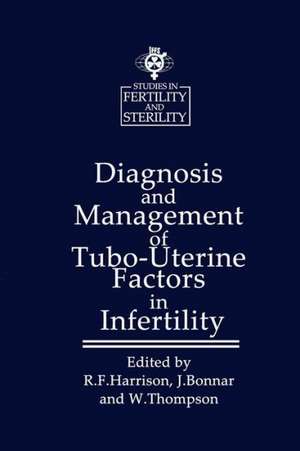Diagnosis and Management of Tubo-Uterine Factors in Infertility: Studies in Fertility and Sterility, cartea 4
Editat de R.F. Harrison, J. Bonnar, W. Thompsonen Limba Engleză Paperback – 22 apr 2012
Preț: 716.45 lei
Preț vechi: 754.15 lei
-5% Nou
Puncte Express: 1075
Preț estimativ în valută:
137.09€ • 143.52$ • 113.43£
137.09€ • 143.52$ • 113.43£
Carte tipărită la comandă
Livrare economică 07-21 aprilie
Preluare comenzi: 021 569.72.76
Specificații
ISBN-13: 9789401176231
ISBN-10: 940117623X
Pagini: 308
Ilustrații: 304 p.
Dimensiuni: 155 x 235 x 16 mm
Greutate: 0.44 kg
Ediția:Softcover reprint of the original 1st ed. 1984
Editura: SPRINGER NETHERLANDS
Colecția Springer
Seria Studies in Fertility and Sterility
Locul publicării:Dordrecht, Netherlands
ISBN-10: 940117623X
Pagini: 308
Ilustrații: 304 p.
Dimensiuni: 155 x 235 x 16 mm
Greutate: 0.44 kg
Ediția:Softcover reprint of the original 1st ed. 1984
Editura: SPRINGER NETHERLANDS
Colecția Springer
Seria Studies in Fertility and Sterility
Locul publicării:Dordrecht, Netherlands
Public țintă
ResearchCuprins
I: The Animal Oviduct.- Section 1: Physiology.- 1 The impact of tubal surgery on early embryonic development in the rabbit oviduct.- 2 Transport of proteins and water out of an artificial hydrosalpinx in the rabbit.- Section 2: Microsurgical Techniques.- 3 Ultrastructural changes of the mucosa in rabbit fallopian tube after reanastomosis.- 4 Quantitative morphometrical and histopathological study in rabbit oviducts following microsurgical treatment.- 5 Reanastomoses of rabbit oviducts with monofilament and polyfilament absorbable sutures — a histological study.- 6 Conventional sutures versus fibrin glue in microsurgical anastomosis of reproductive tissue.- 7 The tissue reaction to different kinds of suture material in the uterus and the oviduct of the rabbit.- 8 Prevention of adhesions and restoring patency during oviduct anastomosis in rabbits: microscope versus loupes.- 9 Inhibition of peritoneal adhesion formation by colchicine.- 10 Prevention of re-formation of pelvic adhesions by ‘Barrier’ methods.- II: Tubo-Uterine Infection.- 11 Scanning electron microscopic studies on the changes of the oviduct due to ageing, menstrual cycle, pregnancy and inflammation.- 12 Chronic histological inflammation and Chlamydia trachomatis in women selected for tuboplasties.- 13 Specific IgG and IgA antibodies to Chlamydia trachomatis in infertile women.- 14 Tuberculosis of the female genital system.- 15 Resistant Ureaplasma urealyticum in infertile patients: a proposed method of treatment.- 16 Prevalence of Ureaplasma uralyticum in habitual spontaneous abortion.- III: Endometriosis.- Section 1: Pathophysiology.- 17 Aetiology of infertility in patients with endometriosis.- 18 Peritoneal fluid 6-keto prostaglandin Fl? levels in women with endometriosis.- 19 Decreasedconcentration of ovarian LH (hCG) receptor in polycystic ovarian disease and endometriosis.- 20 Autoimmune phenomena in infertile patients with endometriosis.- Section 2: Therapy and Results.- 21 Endoscopic cytopuncture in the diagnosis of intraovarian endometriosis.- 22 Objective assessment of medical treatment of endometriosis with gestrinone (R2323).- 23 Treatment of infertility due to endometriosis with low-dosage danazol.- 24 Endometriosis associated with hyperprolactinaemia.- 25 A newly designed conservative surgery for advanced pelvic endometriosis.- 26 Surgical treatment of ovarian endometriosis.- IV: Tubal Factor Diagnosis.- Section 1: Clinical Results of Diagnostic Endoscopy.- 27 Laparoscopic findings in 801 sterile patients.- 28 Improved laparoscopic fertility testing.- 29 Combined endoscopic findings in 682 infertile women and 135 women requesting sterilization reversal.- Section 2: Endoscopic Results in Comparison with Other Techniques.- 30 Diagnostic evaluation of hysterosalpingography in infertile patients.- 31 Endoscopy of the tube (tuboscopy): its prognostic value compared with hysterosalpingography.- 32 Comparison between uterotubal insufflation, hysterosalpingography and laparoscopy.- 33 Diagnostic laparoscopy in primary infertility.- 34 Laparoscopy in the investigation of subfertility.- 35 Laparoscopic findings in 375 women attending the Rotunda Hospital Infertility Clinic.- V: Microsurgery.- Section 1: Case Selection.- 36 Contraindications to tubal restorative surgery. Proposal for a dissuasive laparoscopic score.- 37 The cytology of tubal secretions for selection of salpingostomies by microsurgical technique.- 38 In vitro fertilization and embryo replacement in relation to tubal surgery for infertility.- 39 Psychological issues in mechanical infertility.- Section 2: Special Techniques.- 40 Danazol as an ovulation inhibitor prior to tubal surgery.- 41 Temporary ovarian suspension for prevention of recurrent adhesions after salpingostomy.- 42 Pregnancies after terminal microsurgical tuboplasties with early laparoscopic control on the eighth day.- 43 Laparoscopic and hysteroscopic CO2 laser procedures in infertility.- 44 Microsurgical techniques for selective removal of tubocornual polyps.- Section 3: Clinical Results.- 45 Therapy and long-term results after different operative procedures for extrauterine pregnancy.- 46 Emergency microsurgery.- 47 Pelvic microsurgery in an Irish context.- 48 Microsurgical restoration of tuboperitoneal infertility in 125 women.- VI: Uterus and Vagina.- 49 Hysteroscopy in infertility.- 50 Treatment of intrauterine adhesions.- 51 The place of metroplasty in the management of congenital uterine malformation.- 52 Psychosexual consequences of Vecchietti’s operation in Rockitansky-Küster-Hauser syndrome.- 53 Canalization of mucus in human fertility.- 54 Treatment of cervical mucus infection by means of doxycycline polyphosphate in 53 hypofertile women.

















